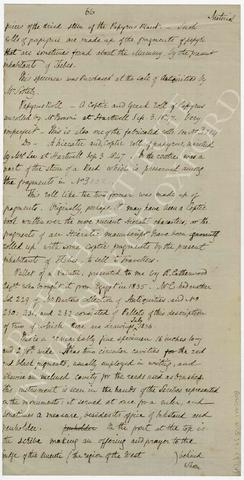
Bereich "Identifikation"
Signatur
Bonomi MSS 39.19 (verso)
Titel
Datum/Laufzeit
Erschließungsstufe
Einzelstück
Umfang und Medium
1 item
Bereich "Kontext"
Name des Bestandsbildners
Bestandsgeschichte
Abgebende Stelle
Bereich "Inhalt und innere Ordnung"
Eingrenzung und Inhalt
Page of handwritten catalogue of Egyptian antiquities:
- ink text on paper
- loose
- 16.0 x 31.6 cm
- [on verso] '66' (ink note)
- [on verso] 'Material' (ink note)
- [on verso] 'pieces of the dried stem of the Payprus Plant. - Such rolls of papyrus are made up of the fragments of papyri that are sometimes found about the mummy by the present inhabitants of Thebes.
This specimen was purchased at the sale of antiquities by Mr Sotheby.
Papyrus Roll - A Coptic and Greek roll of Papyrus unrolled by Mr Bonomi at Hartwell Sep. 3. 1847. Very imperfect - This is also one of the fabricated rolls. See No 3114
Do - A hieratic and Coptic roll of papyrus, unrolled by Mrs Lee at Hartwell Sep 3. 1847. In the centre was a part of the stem of a reed which is preserved among the fragments in No 3102.
This roll like the two former was made up of fragments. Originally, perhaps, it may have been a Coptic book written over the more ancient Hieratic characters; or the fragments of all Hieratic manuscript have been ignorantly rolled up with some Coptic fragments by the present inhabitants of Thebes, to sell to travellers.
Pallet of a Painter, presented to me by R. Catherwood Esqre who brought it from Egypt in 1835. Mr C. had another Lot 229 of Mr Bartons collection of antiquities; and No 230; 231; and 232 consisted of Pallets of this description of two of which there are drawings July 1836.
This is a remarkably fine specimen 16 inches long and 2./8th wide. It has two circular cavities for the red and black pgiments, usually employed in writing, and likewise an inclined cavity for the reeds used as brushes. This instrument is seen in the hands of the scribes represented on the monuments: it served at once for a ruler, and sometimes a measure, besides its office of inkstand and penholder.
penholderOn the front at the top is the scribe making an offering and prayer to the judge of the Amenti (the region of the West) behind whom' (ink note; with '3114' and '3102' in pencil).
Bewertung, Vernichtung und Terminierung
Zuwächse
Ordnung und Klassifikation
Bedingungen des Zugriffs- und Benutzungsbereichs
Benutzungsbedingungen
Reproduktionsbedingungen
Copyright Griffith Institute, University of Oxford
In der Verzeichnungseinheit enthaltene Sprache
Schrift in den Unterlagen
Anmerkungen zu Sprache und Schrift
Physische Beschaffenheit und technische Anforderungen
Findmittel
Bereich Sachverwandte Unterlagen
Existenz und Aufbewahrungsort von Originalen
Existenz und Aufbewahrungsort von Kopien
Verwandte Verzeichnungseinheiten
Bereich "Anmerkungen"
Alternative Identifikatoren/Signaturen
Zugriffspunkte
Zugriffspunkte (Thema)
Zugriffspunkte (Ort)
Zugriffspunkte (Name)
Zugriffspunkte (Genre)
Bereich "Beschreibungskontrolle"
Identifikator "Beschreibung"
Archivcode
Benutzte Regeln und/oder Konventionen
Status
Erschließungstiefe
Daten der Bestandsbildung, Überprüfung, Löschung/Kassierung
Sprache(n)
Schrift(en)
Quellen
Digitales Objekt Metadaten
Dateiname
Bonomi_39_19_verso_res600ppi.jpg
Breitengrad
Längengrad
Medienart
Bild
Mime-type
image/jpeg